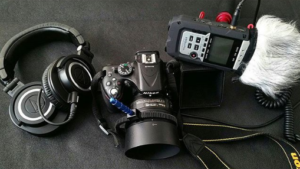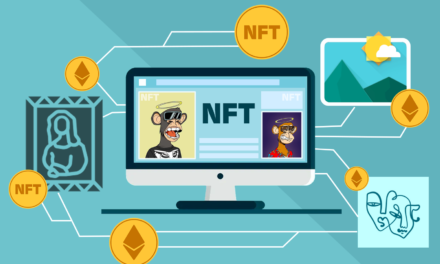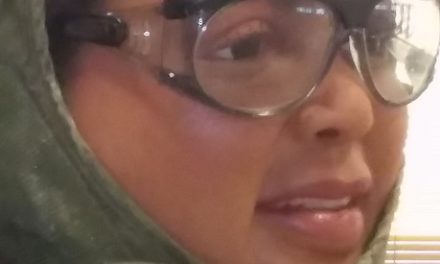The courses offered within the Digital Media Program are defined to create the best foundation for you and your career. It starts from the basics to the more advanced. Particularly, lets focus in on a specific course that may be of interest to those seeking to get into the Digital Production, film, commercial or television career. The course in discussion is basic video. Let’s begin by breaking down how to get the most out of the video class and the benefits and drawbacks within the course.
Basic video is an introductory class for those that have no knowledge of camera operations, editing or techniques. It is designed behind the principles of getting you comfortable being behind the camera and confidently reading your surroundings to get the best footage possible for your needs. The course is accompanied currently with a book entitled, “Video Production Handbook” by Jim Owens & Gerald Millerson. This book is filled with useful information on different equipment and ways to correctly shoot subjects. In the course, you are sent out to a variety of locations to practice techniques and to see from firsthand experience what it takes to get shots or angles that are essential to a videographer’s arsenal. It accompanies projects as well such as an interview, short film, 30 second-day in your shoes and many others that put those skills you learned earlier to practice. However, you can find yourself missing out on these precious resources when you don’t practice the techniques within the book.
One of the essential elements in videography is practicing the skill. It is a skill that is learned through repetitively using the camera and practicing the techniques. If you are on the go and you are shooting something on the fly, which is called, “gorilla shooting”, the moment can be fleeting. If you haven’t practiced ways to quickly set up, white balance and adjust your iso settings, you could end up missing out on a beautiful video of a pelican that is lunging its head in the water searching for fishes. You would then have to rely on editing to see if the shot is recoverable but that is another story. As I have progressed in my videography, I know that you can never learn enough about the art form and you can never become too skilled since every situation is different and you must adapt to it. Furthermore, there are basic cameras that you can check out for the course because camera equipment or any equipment for this career field will become costly. We are talking about lenses that can go up in the tens of thousands. So, keep that in mind if you are choosing this direction as a career path. Similarly, I invested in my own equipment so that I can practice more efficiently techniques at my own leisure. Equipment today can range from cellphones, iPad, go pros and many more. The main concern beyond the equipment is the techniques. The basic video course does offer the essentials to help you develop the skills you need if you have never seriously used a camera.
For the serious enthusiast and professional, you must go beyond the books and the course material for a more complete world view of videography. Most of my skills that I have acquired are from practicing on my own time and watching videos from different YouTube personalities such as a favorite of mine “Film Riot” that shares techniques and contests to help push your skills forward from a community of people that understand the art form inside out.
The following YouTube video is courtesy of Film Riot .
Most importantly, the biggest mistake people make is believing that their work is going to look like Spielberg when they finish the course. It takes times and a deeper understanding of filmmaking to get the look and shots you want. A single course doesn’t do that for you. Like any art form, you must build upon layers and layers of information and techniques to arrive at something that is in the ball park of a professional.
A Digital Media Bachelor student, Eric Riley states the following from his time being within the course. “The most valuable information I learned from video class was to not be afraid to ask for help. If you want to get better, you have to practice as much as you can even if you aren’t shooting. Learn about your camera, play with the buttons on it and get familiar with them. The only thing I wish I would’ve learned more about would be editing and lighting. Editing in that class was very basic, which it is a basic video class. I just wanted more. When it comes to lighting, I personally didn’t gain any knowledge. I had to explore YouTube for tips on that topic.” Eric identifies the benefits and drawbacks within the course. It has many of the key techniques for a basic videographer but for Eric who is a more advanced camera operator, the course doesn’t fulfill his desire for learning the techniques that will push his skills to new levels. Camera study is very in depth and most of the parts will be grazed over or not fully explored. On the topic of lighting. It is one of the crucial elements in videography and could be explored more in depth for the course in the future. Also, Eric hit on a key point in videography, never be afraid to ask for help because videography is a team effort. As you progress in filmmaking, the field gets more and more complicated and will need others to trust and take on roles for you to get the best product and results.
The basic video course offered at Gulf Coast State College is a worthwhile class to take if you are beginning into the field of videography. If you are a more advanced camera operator, it could be used to fulfill requirements and utilize techniques you may have never used or even forgotten. I used the course to help strengthen my skills and refresh my knowledge of basic techniques such as a canted angle which I never knew about. There are areas that could be added more in depth within the program such as lighting but for the most part, the basic videographer is equipped with enough knowledge to explore outside the information that is obtained through the class. YouTube is a great platform to seek out the information you need along with countless videography books on Amazon. Also, through all the information you obtain. You must practice, practice and practice. It is an age-old rule but one that holds true no matter what craft you are learning. Finally, I believe maybe an advanced videography course is needed. A videography two course could explore techniques that students such as Eric are looking for in their camera arsenal. I believe that courses such as basic video are essential at Gulf Coast and play a vital role in educating students, but students must also utilize skills and resources outside of the classroom to gain the most valuable experiences for their educational needs.
About The Author

Perry Ellis
Student - Spring 2018








